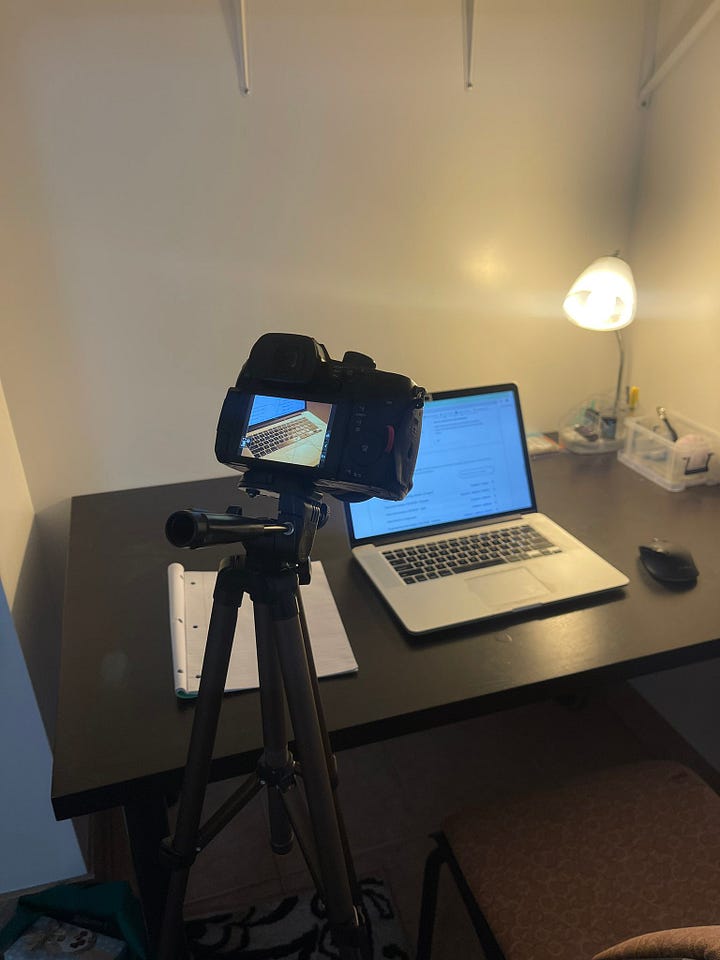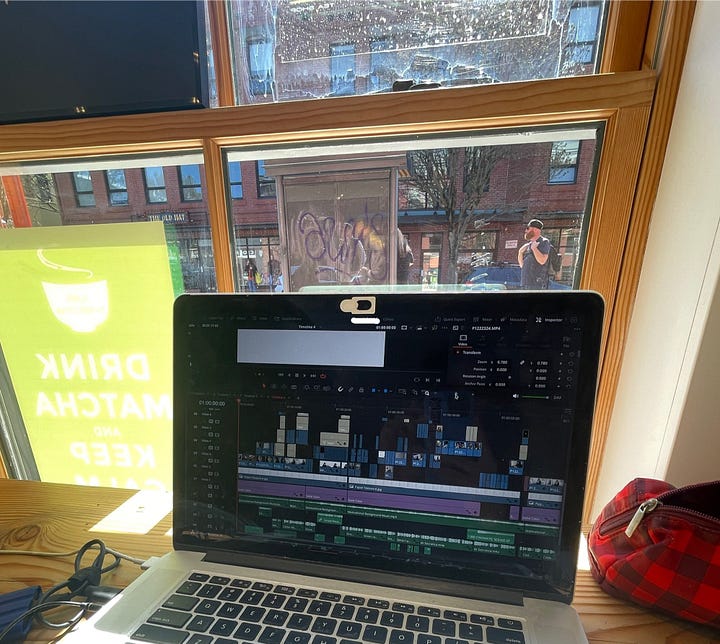How to get a job in 24 hours
On Julia Fedorin’s viral job application, building in public, and what it takes to get noticed in a crowded job market
In an era of endless job applications and automated rejections, one story broke through the noise this week: Julia Fedorin, a University of Waterloo student, posted a 71-second video addressed to Shopify, asking, “Room for one more?” Twenty-four hours later, Shopify’s COO responded publicly: “You are hired. My DMs are open.”
As I write this, Julia’s tweet has nearly a million views and counting. The story has resonated far beyond the design and tech crowd, not because it’s a feel-good fluke, but because it reflects something deeper about how work, hiring, and attention are changing. In a market that often feels like shouting into the void, Julia’s approach offered signal.
Standing out, deliberately
The “skip the line” strategy isn’t new. But it’s gaining traction as AI automates the more mechanical aspects of hiring—cover letters, keyword optimization, even résumé formatting. In response, human qualities like creativity, clarity, and initiative are becoming more valuable, not less.
So what made Julia’s pitch successful when so many others fade into the feed?
First, she kept it brief. Her video runs just over a minute, respects the viewer’s time, and leads with value—not credentials. “I don’t code,” she says, “but I build story, connection, and community.” In that span, she highlights her 10k+ YouTube subscribers, brand collaborations, podcast, event organizing, and track record of showing up.
Second, she did her homework. The tone and content of the pitch were directly aligned with Shopify’s culture—entrepreneurial, high-agency, and self-initiated. That alignment was confirmed by CEO Tobi Lütke’s Slack message behind the scenes: “i have such a weak spot for high agency people.”
Third, she made a clear ask. Julia wasn’t requesting a generic opportunity—she pitched herself for a specific role that didn’t yet exist: Shopify’s first marketing intern. And by framing it that way, she invited Shopify to imagine a future with her already in it.
Finally, she kept at it. Just days before, she had shared similar videos addressed to Microsoft and Adobe. Those didn’t take off—but they were steps toward clarity, not wasted effort. Each post refined her message. Her story wasn’t just about going viral. It was about showing up, again and again.


The calling card approach
In the class I taught with Sebastian, we asked our students to create a “business artifact” or “calling card”—a tangible (or digital) expression of how you think, what you value, and how you work. Not a business card. Something more personal and deliberate. The calling card is:
Not designed to scale
Not reliant on a job listing
Not generic or passive
Instead, it’s made for a specific person, moment, or opportunity. It might be a zine, a video, a checklist, or a microsite. But the point isn’t the format—it’s the clarity. Julia’s video worked not because it was flashy, but because it was focused. It wasn’t just telling people what she could do—it was showing them, in real time. The medium matched the message.
And as AI becomes increasingly capable of simulating polish, clarity becomes the real differentiator. A good business artifact doesn’t just say what you do. It shows how you do it—and why it matters.
The difference between attention-grabbing and connection-building
Of course, not every creative approach lands this well. For every Julia Fedorin, there are dozens that miss the mark. I’ve heard of applicants sending everything from pizzas to skateboards to… bricks. (They did not get the job.) So what separates a thoughtful initiative from a desperate attention grab? Purpose and relevance.
Creative outreach works when it reflects the applicant’s actual strengths and is tailored to the opportunity. It fails when it’s performative, gimmicky, or out of step with the role. Jennifer Whitney shared one story that stuck: “They lived in Portland and applied for a position at W+K in NYC. They hired their friend to tape an iPad to their head and walk into the interview while connected to FaceTime. He got the job!”
Alberto Romero found success with a more sustained approach: “After meeting for an informal chat, my interviewers asked me to keep them posted. So I created a newsletter and signed them all up. I wrote and sent seven issues—then got hired.”
The common thread among successful approaches is that they demonstrate the exact qualities the role requires. An advertiser gets on the radar of Google’s top creative directors. An art director launches a fictitious new division. A video marketer creates a compelling video. A creative coder (and former student) finds an interactive way to bridge distance.
Making your own
If you’re inspired to create your own artifact, here are some principles to consider:
Start with clarity: What are you uniquely good at? What kinds of problems do you want to solve? For whom?
Choose the right medium: Choose a format that demonstrates your skills. If you’re a writer, write. If you’re a designer, design. If you’re a filmmaker, film.
Make it relevant: Research the company. Understand their values. Tailor your message.
Focus on problems you can solve: Companies hire people to solve problems. Show you understand what those problems are.
Be authentic: Quirky works when it’s true to you. Don’t perform someone else’s version of creativity.
Offer a clear next step: Make it easy to respond, forward, or say yes.
High agency is the real differentiator
Beyond tactics, the underlying principle here is what people in Silicon Valley call “high agency”—the ability to take action independently, without waiting for permission or perfect conditions. This also aligns with what many leaders are actively looking for: people who can operate without constant direction, who can identify problems and opportunities, then take initiative to address them
As Peter Yang puts it in a recent video: “Stop asking to ‘hop on a call,’ ‘pick someone’s brain,’ or ‘grab coffee.’ Stop chasing the same schools and job titles as everyone else. Instead: don’t wait for permission to do your best work.”
This doesn’t mean being reckless or disrespectful of norms. It means understanding which rules are flexible and which opportunities are there for the taking if you’re bold enough to reach for them.
Finding your own path
The real take-away from Julia’s success isn’t that everyone should start making videos for their dream companies (though if that aligns with your skills, go for it). It’s that standing out requires finding the intersection of:
What you’re genuinely good at
What the company genuinely needs
A format that demonstrates both
So next time you find yourself staring at yet another online application form, ask yourself: Is there a more direct path? Could I create something that shows, rather than tells? Is there a way to stand out by simply being bold enough to ask for what I want? Julia did, and it worked. Maybe it’s your turn.
—Carly




![A four-panel image showing Julia Fedorin’s rapid journey to becoming an intern at Shopify in under 24 hours. Each panel includes a timestamp and caption: Left panel (8:05pm): Julia, smiling with her hand over her mouth, appears surprised. Caption: “being invited to an interview.” Text bubble reads, “Julia things are happening.” Second panel (10:35pm): Julia looks excited while preparing for her interview. Caption: “prepping for interview.” Text bubble reads, “let’s get you an internship.” Third panel (5:28am): Julia, looking happy, is in the interview. Caption: “joining interview.” Text bubble reads, “I was just told you got the offer.” Right panel (11:14am): Julia, again with her hand over her mouth in joy, says yes to the offer. Caption: “saying yes to offer!” A text message above reads, “I can’t wait. This is my favourite story Julia ❤️❤️❤️.” At the top, text reads: “i became an intern at [Shopify logo] in under 24 hrs.” A four-panel image showing Julia Fedorin’s rapid journey to becoming an intern at Shopify in under 24 hours. Each panel includes a timestamp and caption: Left panel (8:05pm): Julia, smiling with her hand over her mouth, appears surprised. Caption: “being invited to an interview.” Text bubble reads, “Julia things are happening.” Second panel (10:35pm): Julia looks excited while preparing for her interview. Caption: “prepping for interview.” Text bubble reads, “let’s get you an internship.” Third panel (5:28am): Julia, looking happy, is in the interview. Caption: “joining interview.” Text bubble reads, “I was just told you got the offer.” Right panel (11:14am): Julia, again with her hand over her mouth in joy, says yes to the offer. Caption: “saying yes to offer!” A text message above reads, “I can’t wait. This is my favourite story Julia ❤️❤️❤️.” At the top, text reads: “i became an intern at [Shopify logo] in under 24 hrs.”](https://substackcdn.com/image/fetch/$s_!8ZAv!,w_1456,c_limit,f_auto,q_auto:good,fl_progressive:steep/https%3A%2F%2Fsubstack-post-media.s3.amazonaws.com%2Fpublic%2Fimages%2F201c6f17-9db6-4018-aea3-4e72d35bcd69_1200x486.png)



TFW you’re reading Carly and see your name 🖤
(By the way, I deleted all my tweets so the I guess original conversation is gone, glad you kept it filed!)
She was clever, there is no denying that.
And yet, more than a blueprint for hiring talent, this looks like the Stanley-Cup-Survives-car-fire viral moment. Company responded because she sensed the opportunity for some free visibility (and goodwill). A paid internship isn't such a big price to pay.